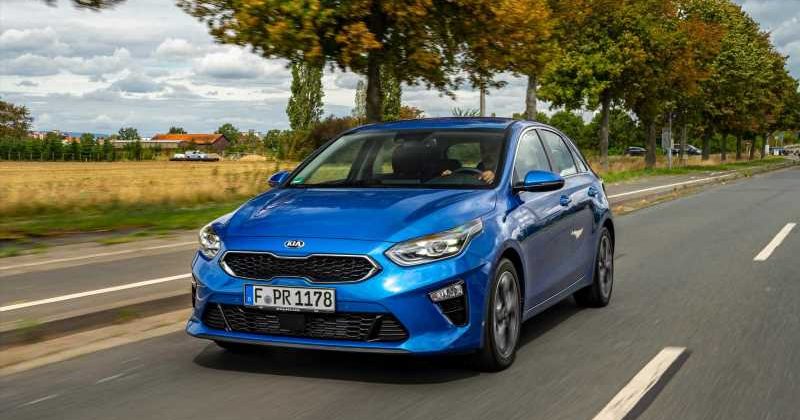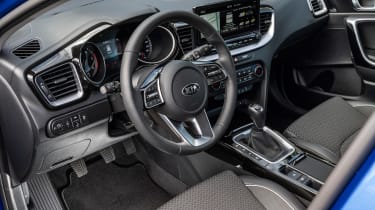Kia’s ingenious new fuel-saving manual transmission lets the Ceed hatchback coast even when it’s in gear.
4.0 out of 5
Verdict
KIA believes that its clever new iMT system will deliver a modest reduction in fuel consumption and CO2 emissions, and the figures and our early drive show promise. The system’s action feels little different from any conventional clutch pedal, and promises the added benefit of reducing wear. The Ceed’s updated infotainment tech, meanwhile, just improves what was already one of the best systems in the segment.
There’s no denying that Kia is at the forefront when it comes to producing electric powertrains, but the company still feels that there’s life in the old internal combustion engine yet.
Kia’s latest bid to trim fuel consumption is known as Intelligent Manual Transmission (iMT) coupled with a 48-volt mild-hybrid system. We’re trying it here for the first time in the Ceed hatchback, where it’s paired up with the existing 136bhp diesel. UK sales are expected to begin for the Ceed and its derivatives – XCeed, Proceed and Ceed Sportswagon – at around the turn of the year, while the same system will make its way into 1.0-litre turbo petrol versions of the Rio and Stonic before the end of 2020.
Best hatchbacks to buy now 2020
- Kia Ceed SW vs Renault Megane Sport Tourer vs Skoda Octavia Estate
- Skoda Scala vs Volkswagen Golf vs Kia Ceed
- Kia Ceed review
- Kia Ceed Sportswagon review
- Kia Ceed GT-Line S: long-term test review
- New Kia Ceed GT 2019 review
- Used Kia Cee’d review
The key to the new system is replacing the traditional hydraulic clutch linkage with an electro-hydraulic one. This allows the clutch to open so that the engine can be switched off, even with the car in gear.
More reviews for Ceed
Car group tests
In-depth reviews
Long-term tests
Road tests
Used car tests
In practice, it works like this: imagine you’re approaching a junction, so you ease off the accelerator and begin to coast. With no throttle applied, the iMT system can open the clutch and switch off the engine, in effect letting the car ‘sail’ with as little mechanical drag as possible. As soon as the accelerator is pressed, the engine fires into life almost instantly thanks to the electric starter/generator and the energy stored in the 48-volt battery. Clever.
If you’re coasting from high speeds, you might drop below that gear’s limits, which could cause the engine to labour, or even stall, if the clutch is re-engaged. In this case, the engine stays off and the clutch open until either the correct gear is selected, or the speed matches the chosen ratio.
On the road, the electric clutch feels like any other mechanical system. The pedal has a constant weight throughout its travel, and the biting point is always in the same place. It will continue to stay there when the clutch is coming to the end of its life, too – a life Kia says will be extended thanks to iMT’s ability to more consistently and accurately engage compared to a human input.
As in other Ceed models there are three driving modes – Eco, Normal and Sport – but the sailing function is only available in Eco. Regardless of the setting, the 1.6-litre diesel unit feels a little lazy; fuel saving takes priority over a sporty feel – as it should for a family hatchback.
We’ll need to try the car for a more extended period in the UK to be sure of any real-world fuel-saving potential, but the indicated 60.1mpg on our German test route is a promising start. Kia says that the combination of the mild-hybrid system and iMT helps to cut emissions by three per cent, with WLTP figures set between 98g/km and 103g/km. That places the Ceed iMT into the 22 and 23 per cent Benefit-in-Kind brackets.
The rest of the driving experience is the same as in any other version of the Ceed; a deft balance between ride and handling, precise, well weighted steering, and decent refinement mean that it’s above average for the class.
Elsewhere, the Ceed family benefits from a new 10.25-inch touchscreen infotainment system that we’ve already seen in the Niro. It’s arguably the best such set-up available among the mainstream manufacturers, with clear graphics, quick loading times and a logical interface. The entry-level Ceed continues with a smaller eight-inch display, but like the larger units, this gets Apple CarPlay and Android Auto as standard.
The larger infotainment screen allows integration with Kia’s latest UVO Connect software. This can plot navigation ETAs more accurately by using both real-time and historical traffic data, while the smartphone app now offers augmented-reality Last Mile Navigation and car status updates.
Kia has yet to confirm prices for the Ceed iMT models, but the mid-level 3 trim of our test car, with 17-inch alloys, climate control, a reversing camera and that larger screen system, should cost roughly £24,500.
| Model | Kia Ceed 1.6 CRDi 48V iMT 3 |
| Price | £24,500 (est) |
| Engine | 1.6-litre 4cyl mild-hybrid diesel |
| Power/torque | 136bhp/280Nm |
| Transmission | Six-speed manual, front-wheel drive |
| 0-62mph | 10.2 seconds |
| Top speed | 124mph |
| Economy/CO2 | 64mpg (est) / 99g/km |
| On sale | January 2021 |
Source: Read Full Article



 Best hatchbacks to buy now 2020
Best hatchbacks to buy now 2020